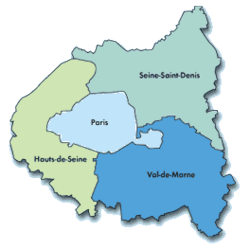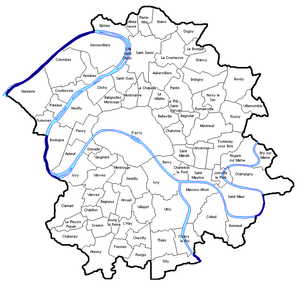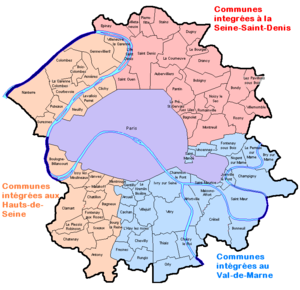- Seine (department)
-
Seine was a département of France encompassing Paris and its immediate suburbs. Its préfecture (capital) was Paris and its official number was 75. The Seine département was abolished in 1968 and its territory divided among four new départements.
Contents
General characteristics
The Seine département was created on March 4, 1790 under the name Paris département (French: département de Paris). In 1795 the name was changed into Seine département (French: département de la Seine), after the Seine River flowing through it.
From 1929 to its abolition in 1968, the department consisted of the city (commune) of Paris and 80 suburban communes surrounding Paris. It had an area of 480 km² (185 sq. miles), 22% of that area being the city of Paris, and 78% being independent suburbs. It was divided into three arrondissements: Paris, Sceaux, and Saint-Denis.
Split-up
At the first French census in 1801, the Seine département had 631,585 inhabitants (87% of them living in the city of Paris, 13% in the suburbs) and was the second most populous département of the vast Napoleonic Empire (behind the Nord département), more populous than even the dense départements of what is now Belgium and the Netherlands. With the growth of Paris and its suburbs, the population of the Seine département increased tremendously, and by 1968 it contained 5,700,754 residents (45% of them living in the city of Paris, 55% in the suburbs), being now by far the most populous département of France. It was judged that the Seine département was now too large and ungovernable, and so on January 1, 1968 it was split into four smaller départements: Paris, Hauts-de-Seine, Seine-Saint-Denis, and Val-de-Marne.
In detail, the break-up of the Seine département was carried out like this:
- the city (commune) of Paris was turned into a département in its own right, with no other communes inside this département. The official number 75 which was used for the Seine département was given to the new Paris département.
- To the south and south-east of the city, 29 communes of the Seine département were grouped with 18 communes of the Seine-et-Oise département (which was also abolished in 1968) to form the new Val-de-Marne département, and the official number 94 was assigned to this département (a number previously used for the Territoires du Sud territory in the Saharan part of French Algeria).
- To the west of Paris, 27 communes of the Seine département were grouped with nine communes of Seine-et-Oise to form the new Hauts-de-Seine département, and the official number 92 was assigned to this département (a number previously used for the département of Oran in French Algeria).
- Finally, to the north and north-east the 24 remaining communes of the Seine département were grouped with 16 communes of the Seine-et-Oise département to form the new Seine-Saint-Denis département, and the official number 93 was assigned to this département (a number previously used for the département of Constantine in French Algeria).
Taken together, Hauts-de-Seine, Val-de-Marne, and Seine-Saint-Denis, three départements known in France as the petite couronne (i.e. "small ring", as opposed to the "large ring" of the more distant suburbs), plus the city of Paris, are larger than the former Seine département (480 km² for the Seine département vs. 762 km² for Paris and petite couronne).
Population
At the 2006 census, the population of the communes that had previously comprised the Seine département was 5,496,468. The population of the département peaked in 1968 at 5,700,754. It then lost inhabitants until 1999 (nadir of 5,203,818 inhabitants at the 1999 census) as residents increasingly relocated to the more distant suburbs of the metropolitan area of Paris, but since 1999 it has regained some inhabitants, with a population increase of 292,650 inhabitants between 1999 and 2006. This new population growth after a long period of decline is comparable to what is observed in the central areas of other large Western metropolises such as Inner London.
Of the new départements created in 1968, Paris (75) was the most populous in 2006 with 2,181,371 inhabitants. The Paris département is currently the second-most populous of France behind that of Nord.
Controversy over the break-up
 Paris and petite couronne: the four départements created in 1968 when the Seine and the Seine-et-Oise départements were abolished. The four départements are altogether larger than the former Seine département.
Paris and petite couronne: the four départements created in 1968 when the Seine and the Seine-et-Oise départements were abolished. The four départements are altogether larger than the former Seine département.
Today, there are some people in France who regret the break-up of the old Seine département. In the 1960s it was felt that the département was too large to be properly governed, and everybody welcomed the change. However, in the last 40 years large ghettos have appeared in the suburbs of Paris, while the city of Paris itself has become more of a place for the wealthy, with the departure of lower-middle-class residents to the suburbs. The building of the large Périphérique freeway all around the city of Paris also contributed to the feeling of marked segregation between Paris proper and its suburbs. Many politicians and intellectuals regret the loss of the old Seine département in the sense that before there existed a common administration for the city of Paris and its immediate suburbs, creating a sense of community throughout the metropolitan area, whereas today rich Paris administers itself solely and leaves the suburbs to their own fate.
However, so far there are no real plans to revive the old Seine département. Moreover, the creation of the Île-de-France région in the 1970s, which encompasses not only the territory of the former Seine département, but also the more distant suburbs of Paris, may in time prove to be the unifying structure for the metropolitan area that was once the Seine département.
Categories:- Former departments of France in France
- States and territories established in 1790
Wikimedia Foundation. 2010.


